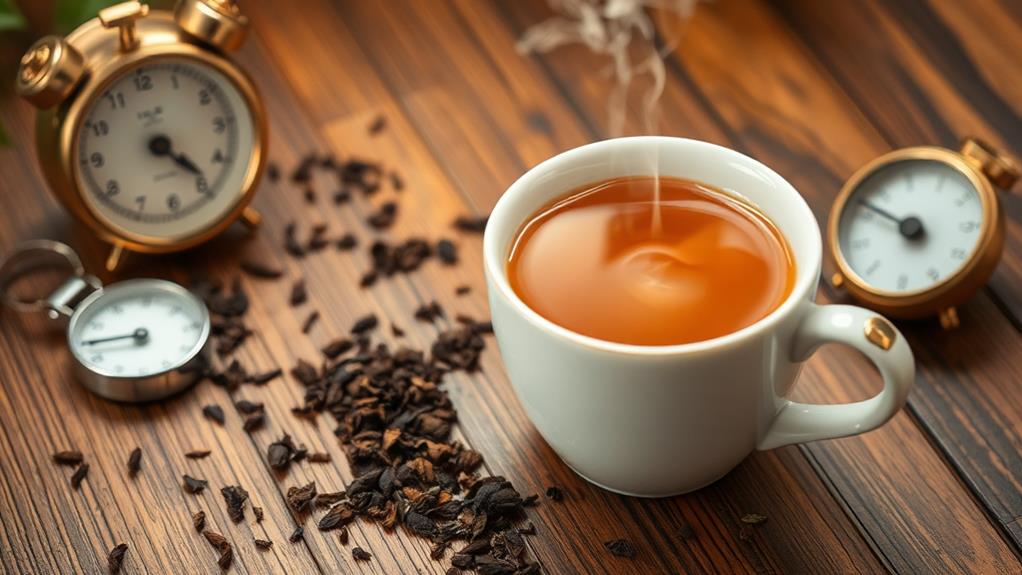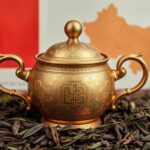Your tea gets bitter mainly due to steeping time, temperature, and the quality of the leaves. If you use water that's too hot or steep for too long, you'll release more tannins, which make it taste bitter. To avoid this, stick to the ideal temperatures for each tea type—like 160°F for green tea and 200°F for black tea—and try not to steep longer than necessary. Also, using high-quality, fresh loose leaf tea can improve flavor. By paying attention to these details, you can brew a delightful cup. Stick around, and you'll discover even more tips for perfecting your tea!
Understanding Tea Bitterness
Understanding Tea Bitterness
Tea bitterness often arises from the delicate balance of factors during brewing. When you steep your tea, various tea compounds interact to create the flavor profile you love. However, if that balance tips too far, bitterness can creep in and take over. It's all about how those compounds, like tannins and catechins, work together.
The quality of your water plays a significant role in this process, as high water quality is essential for optimal tea brewing.
To achieve the perfect flavor balance, you'll want to pay close attention to how much tea you use. Too many leaves can lead to an overpowering taste, while too few might leave your cup feeling flat. Additionally, the quality of your tea is crucial—fresh, high-quality leaves generally yield a smoother experience.
You might also want to experiment with your steeping time. Yes, we'll save that for later, but know that even a minute can dramatically change the flavor.
Temperature and Brewing Times
When it comes to brewing a perfect cup of tea, the right temperature and steeping time are key. Each type of tea has its own ideal brewing parameters that can significantly affect the flavor.
If the water's too hot or you steep it too long, you might end up with a bitter taste that ruins your experience. To avoid this, it's important to know the correct temperature ranges for different teas, such as brewing green tea at 175-185°F to achieve its refreshing taste.
Let's explore how to find that sweet spot for both temperature and time to enjoy a deliciously smooth cup!
Ideal Brewing Temperature
To brew a perfect cup of tea, you need to pay attention to the ideal brewing temperature and time. Each type of tea requires a specific temperature to unlock its best flavors without turning bitter.
For instance, explore the various tea types to understand how different teas can enhance your drinking experience. Using precise temperature gauges can help you achieve this, especially when working with various brewing vessels.
Here are some ideal temperature ranges for different teas:
- Green Tea: 160°F – 180°F
- White Tea: 160°F – 185°F
- Oolong Tea: 185°F – 205°F
- Black Tea: 200°F – 212°F
- Herbal Tea: 210°F – 212°F
By following these guidelines, you can avoid that unpleasant bitterness. If you brew green tea too hot, it may taste astringent and harsh.
Similarly, brewing black tea at lower temperatures can leave it flat and lifeless.
Experiment with different brewing vessels to see how they affect the temperature. A good kettle with a built-in temperature gauge makes this process easier and more fun!
Optimal Steeping Duration
Achieving the perfect balance of flavor in your tea relies heavily on optimal steeping duration. You might be surprised to learn that even slight timing adjustments can drastically change your tea's taste. If you steep too long, you risk bitterness; if you don't steep enough, your tea may taste weak.
Different teas also require specific temperatures to unlock their optimal flavors, which can further influence your brewing success. So, let's dive into some innovative steeping techniques!
Different types of tea require different steeping times. For instance, delicate green teas need only about 2 to 3 minutes, while robust black teas thrive with 4 to 5 minutes. Experimenting with these times can lead to delightful discoveries!
Proper water-to-tea ratios also play a vital role in achieving the best flavor profile.
Using a timer can be a game-changer; it ensures you're precise with your steeping. If you find your tea turning bitter, try reducing the steeping time by 30 seconds. On the flip side, if your cup tastes flat, add a minute.
Quality of Tea Leaves
Quality of Tea Leaves
How can the quality of tea leaves make or break your brewing experience? The truth is, the right tea leaf quality can elevate your cup from ordinary to extraordinary.
When you choose tea, consider the tea leaf types and their origin, as these factors significantly impact flavor and bitterness. Additionally, opting for loose leaf tea can't only enhance your drinking experience but also contribute to reducing environmental waste, as loose leaf tea reduces contribution to landfill waste.
Here are some key points to keep in mind:
- Freshness: Opt for loose leaf tea over pre-packaged bags for better taste.
- Origin: Explore different tea leaf origins, like Darjeeling or Assam, as they offer unique profiles.
- Processing: Look for teas that have been carefully processed; this affects bitterness levels.
- Storage: Store your tea in a cool, dark place to maintain its quality.
- Visual Inspection: Check for whole, unbroken leaves; they often produce a smoother brew.
Tea Type and Characteristics
When you dive into the world of tea, understanding the different types and their unique characteristics can greatly enhance your brewing experience. Each tea type boasts distinct flavor profiles, aromas, and caffeine content, influenced by leaf oxidation and regional differences. Here's a quick guide to help you navigate:
| Tea Type | Key Characteristics |
|---|---|
| Green Tea | Light flavor, low caffeine, minimal oxidation |
| Black Tea | Strong flavor, high caffeine, fully oxidized |
| Oolong Varieties | Complex flavors, moderate caffeine, partially oxidized |
| Herbal Blends | Diverse ingredients, caffeine-free, rich aromas |
| Specialty Teas | Unique blends, often region-specific, innovative flavors |
Whether you prefer a refreshing green tea or a robust black tea, knowing these traits helps you choose the right brewing methods. For instance, green tea thrives at lower temperatures, while black tea needs boiling water. Oolong varieties can be versatile, adapting to both methods. Experiment with herbal blends to discover innovative teas that surprise your palate. Embrace the journey of tea exploration, and you'll avoid bitterness while enjoying every sip!
Water Quality and Its Impact
When making tea, the quality of your water can really make a difference in taste.
Factors like pH levels, mineral content, and temperature all play a role in how your brew turns out, and you might be surprised at how they affect bitterness.
Water Ph Levels
Water pH levels play a crucial role in determining the quality of your tea. When you brew tea, the water's acidity can affect how the flavors develop, sometimes leading to that unwelcome bitterness.
Ideally, you want your water's pH to be around 6.5 to 7.5 for the best results. Here's how pH levels can impact your tea experience:
- Acidity Balance: Higher acidity can amplify bitterness, making your tea less enjoyable.
- Flavor Extraction: The right pH helps extract flavors smoothly, enhancing your tea's aroma and taste.
- Tea Type Sensitivity: Different teas react uniquely to pH levels; green tea is particularly sensitive.
- Mineral Balance: Minerals in water interact with pH levels, influencing the overall flavor profile.
- Brewing Time: pH affects how quickly flavors are released, so experimentation can lead to better brews.
Mineral Content Effects
The mineral content in your water significantly influences the overall quality of your tea. If you want to brew the perfect cup, understanding mineral balance is key.
Water hardness, which refers to the amount of dissolved minerals like calcium and magnesium, can make a big difference. When your water is too hard, it can lead to an overly bitter flavor that masks the subtlety of your tea's natural notes.
On the flip side, soft water may lack essential minerals, resulting in a flat taste. The ideal mineral balance enhances the extraction of flavors without overwhelming them. It's like having the right ingredients in a recipe; too much of one can spoil the dish!
To optimize your tea experience, consider testing your water's hardness. You might want to try filtering your water or using bottled options that maintain a good mineral balance.
Experiment with different water sources to find what works best for your favorite tea. Remember, your tea deserves the best foundation to shine.
With a little attention to your water's mineral content, you'll brew cups that are bursting with flavor and free from bitterness!
Temperature and Taste
How does temperature influence the taste of your tea?
It's crucial to understand that the temperature of the water you use can make or break your tea flavor. Different brewing methods call for specific temperatures, and using the wrong one can lead to unwanted bitterness.
Here's how temperature impacts your brew:
- High temperatures extract tannins: If your water's too hot, it pulls out bitter compounds.
- Lower temperatures preserve sweetness: Cooler water allows delicate flavors to shine, especially in green and white teas.
- Brewing time matters: Longer steeping at high temperatures can lead to an overly strong, bitter taste.
- Flavor balance: The right temperature helps maintain a balance between sweetness and bitterness.
- Experimentation: Don't hesitate to try different temperatures to discover your perfect cup!
Storage and Freshness of Tea
Since proper storage is crucial for maintaining the freshness of tea, you'll want to pay close attention to how you keep your tea leaves. To ensure your tea stays aromatic and flavorful, invest in quality tea packaging. Airtight containers are your best friends here. They protect against moisture, light, and air, all of which can lead to bitterness in your brew.
You might also consider freshness indicators. Some innovative brands offer packaging that changes color when the tea's freshness is compromised. How cool is that? This little feature not only helps you enjoy your tea at its best but also adds a fun twist to your tea-drinking experience.
Make sure to store your tea in a cool, dark place, away from strong odors and humidity. Trust me, it's worth it!
And remember, once you open a bag of loose leaf or tea bags, try to consume them within a few weeks for the best taste. By following these simple tips, you'll keep your tea fresh and delicious, reducing the risk of bitterness.
Brewing Equipment and Techniques
When it comes to brewing the perfect cup of tea, the right equipment and techniques make all the difference. You might think a simple teabag is all you need, but experimenting with different brewing vessels and steeping methods can elevate your tea experience.
Here's how to get started:
- Select the right brewing vessel: Glass, clay, or stainless steel can affect flavor. Choose one that suits your style!
- Control water temperature: Different teas require specific temperatures. Green tea loves cooler water, while black tea thrives in boiling.
- Adjust steeping time: Steeping too long can lead to bitterness. Use a timer to keep your steeping precise.
- Explore loose leaf vs. bags: Loose leaf tea often has more flavor potential. Try it out for a richer experience!
- Know your tea types: Each variety has its quirks. Learning these will help you master your brewing.
FAQ
Can I Reuse Tea Leaves Without Making the Tea Bitter?
Yes, you can reuse tea leaves! To avoid bitterness, experiment with steeping techniques like shorter times or cooler water. This way, you'll enjoy flavorful brews without compromising quality, maximizing your tea leaf reuse.
Does Adding Milk or Sugar Reduce Bitterness in Tea?
Think of your tea as a canvas; adding milk alternatives or various sweetener types can create a masterpiece. They soften bitterness, enhancing flavor without overpowering. Experiment and discover the balance that excites your palate!
How Does My Mood Affect the Taste of My Tea?
Your mood affects your tea's taste significantly. Positive emotional contexts enhance flavor perception, making it richer and more enjoyable, while negative moods can distort your experience, leading to a less satisfying cup. Embrace the innovation of mindfulness in tea enjoyment!
Are There Specific Brands Less Likely to Taste Bitter?
When you choose tea types, consider brands that emphasize quality and specific brewing temperatures. Innovative blends often highlight optimal brewing conditions, ensuring a smoother taste. Experiment with different brands to discover those less prone to bitterness.
Can the Time of Day Influence Tea Bitterness?
Yes, the time of day can influence tea bitterness. Your morning rituals might favor lighter brews, while afternoon preferences could lean towards bolder flavors. Experiment with different types to discover innovative blends that suit your taste.
Final Thoughts
In conclusion, avoiding bitter tea is easier than you might think! By paying attention to brewing times, water temperature, and the quality of your tea leaves, you can make a cup that's as delightful as a sunny day in spring. Remember to use fresh water and store your tea properly for the best flavor. With a few simple adjustments, you'll transform your tea experience from bitter to blissful, leaving you wondering how you ever sipped anything else!



